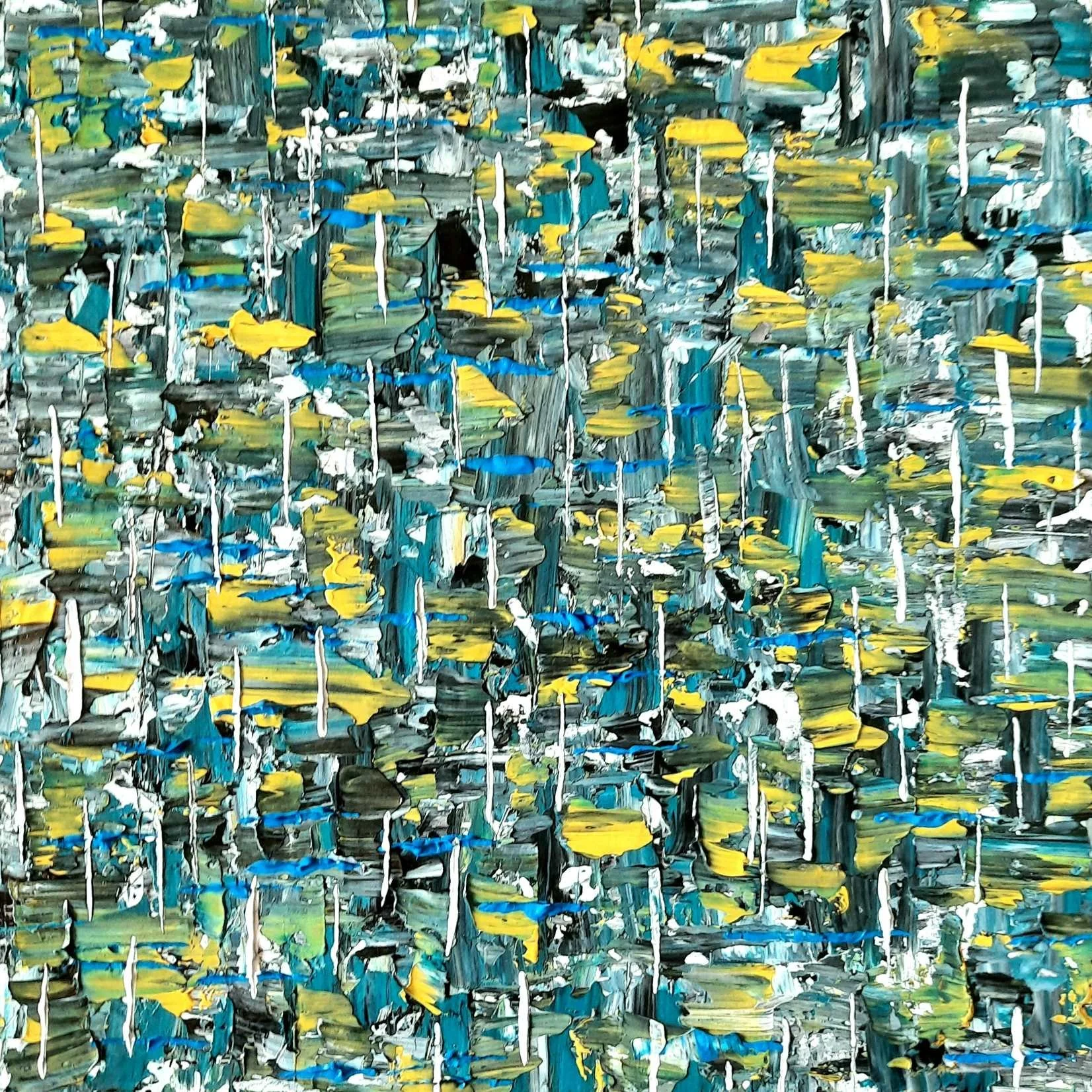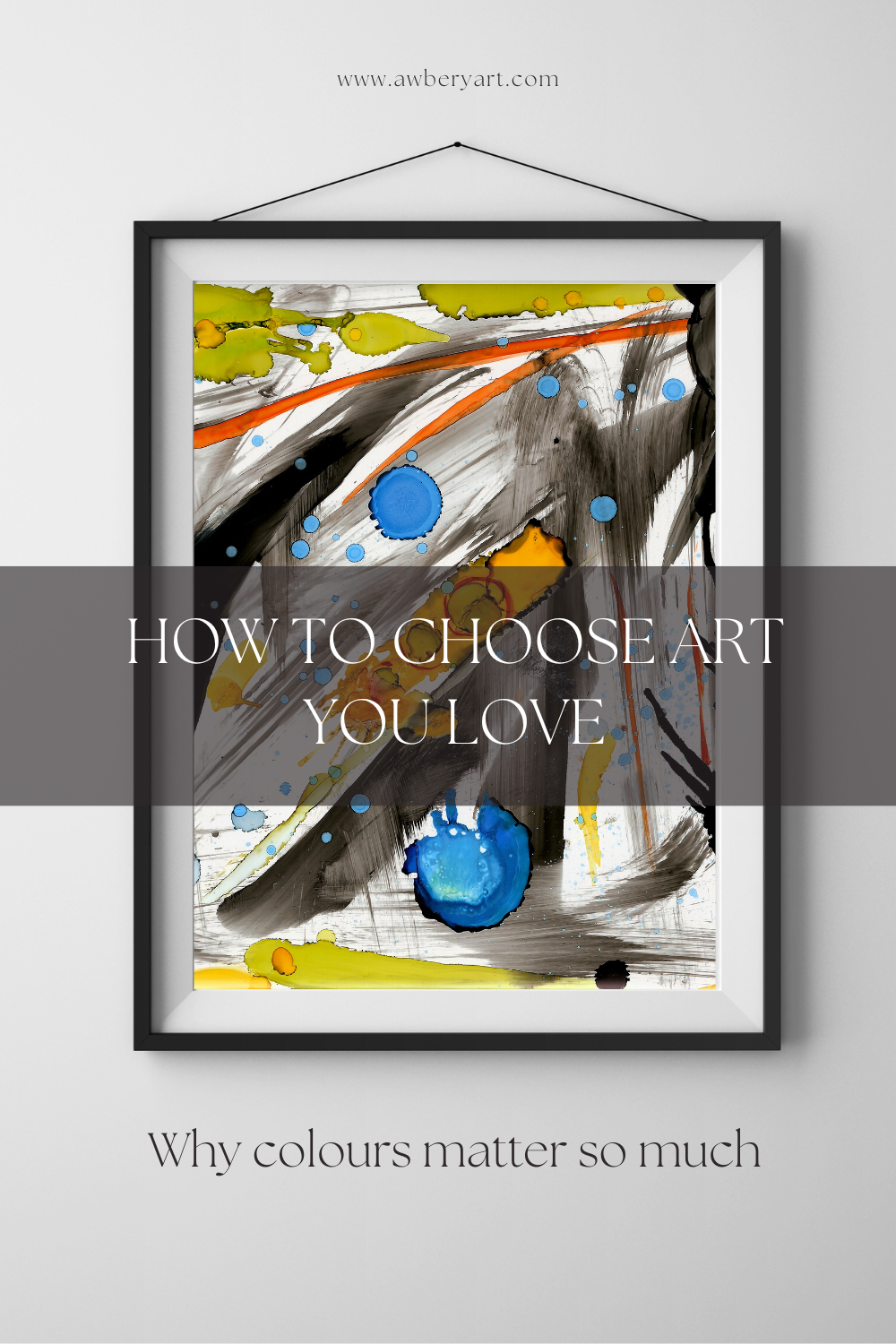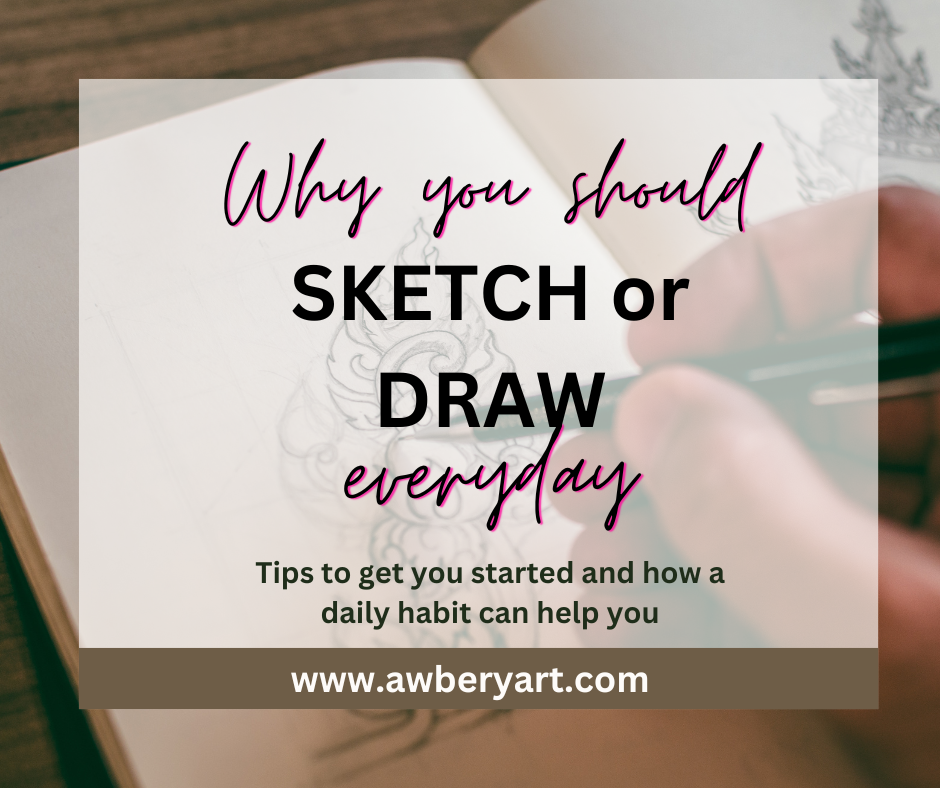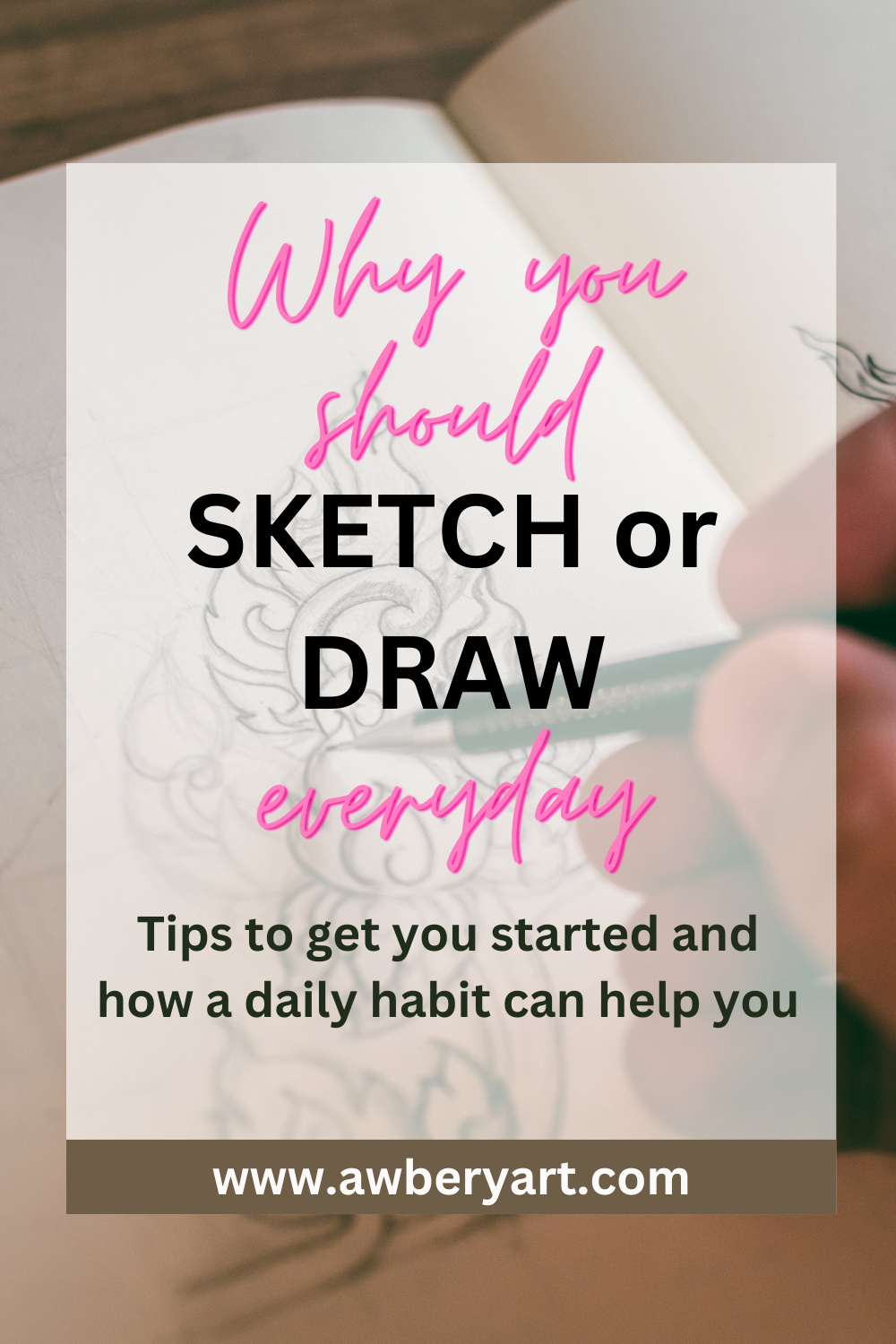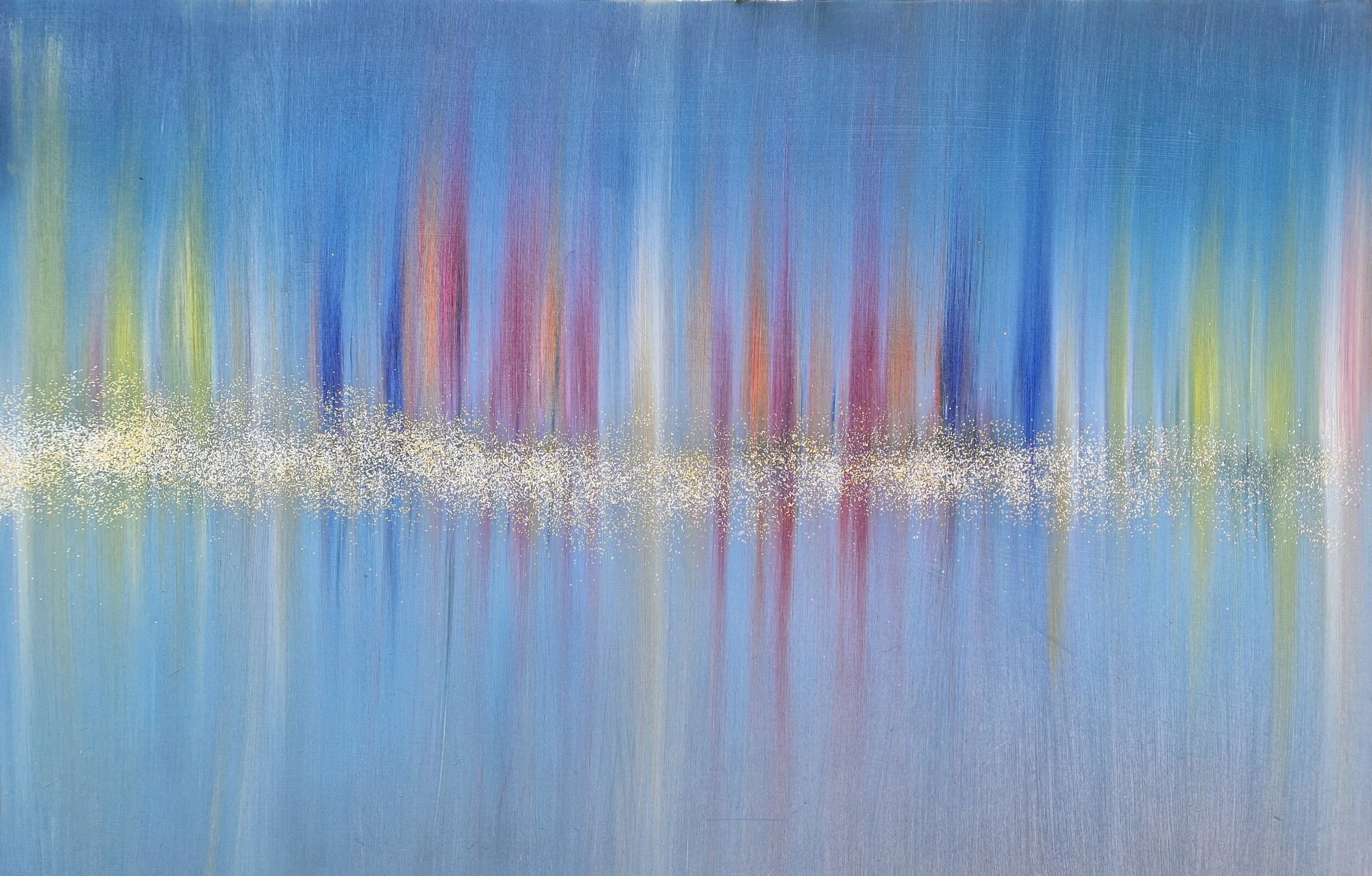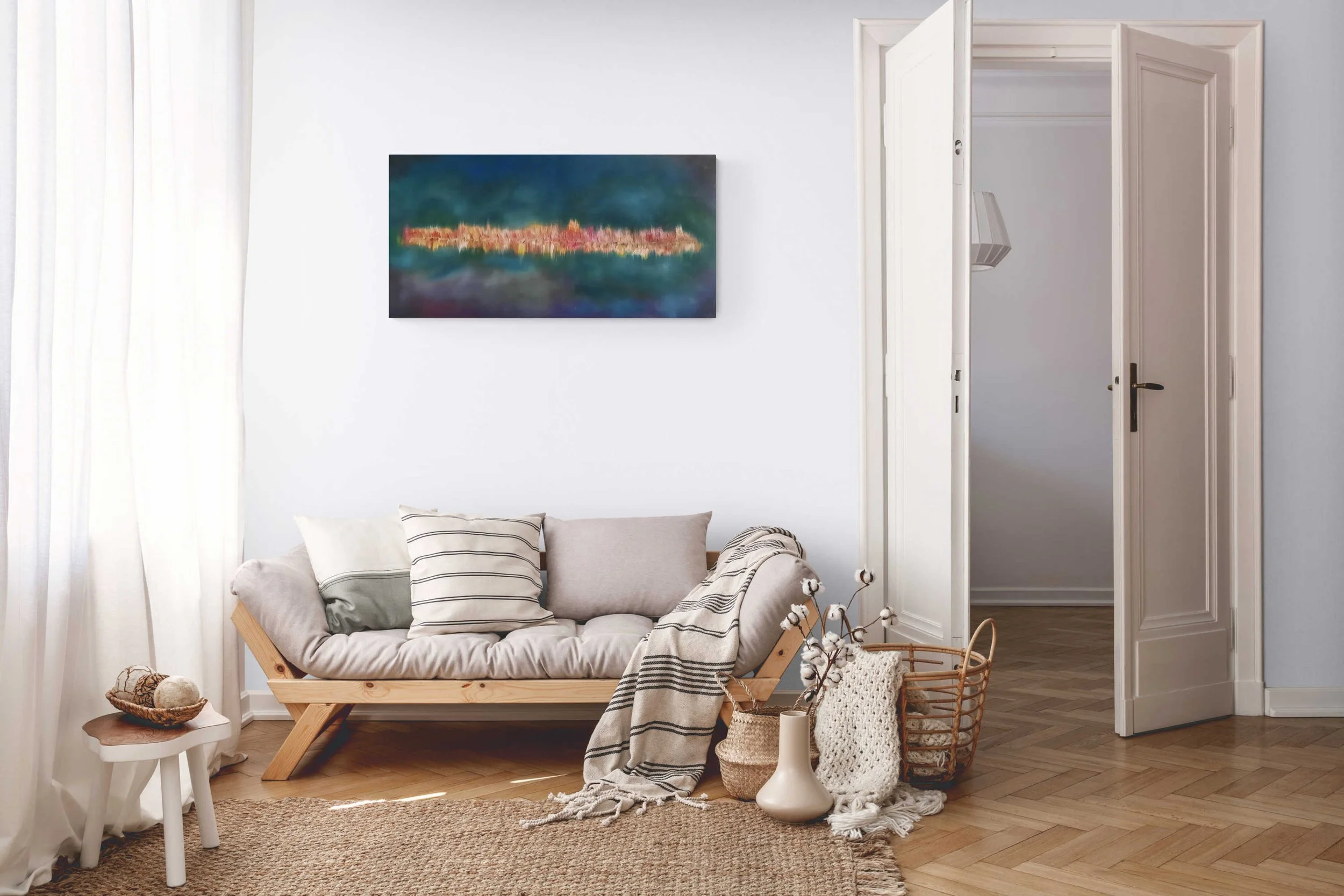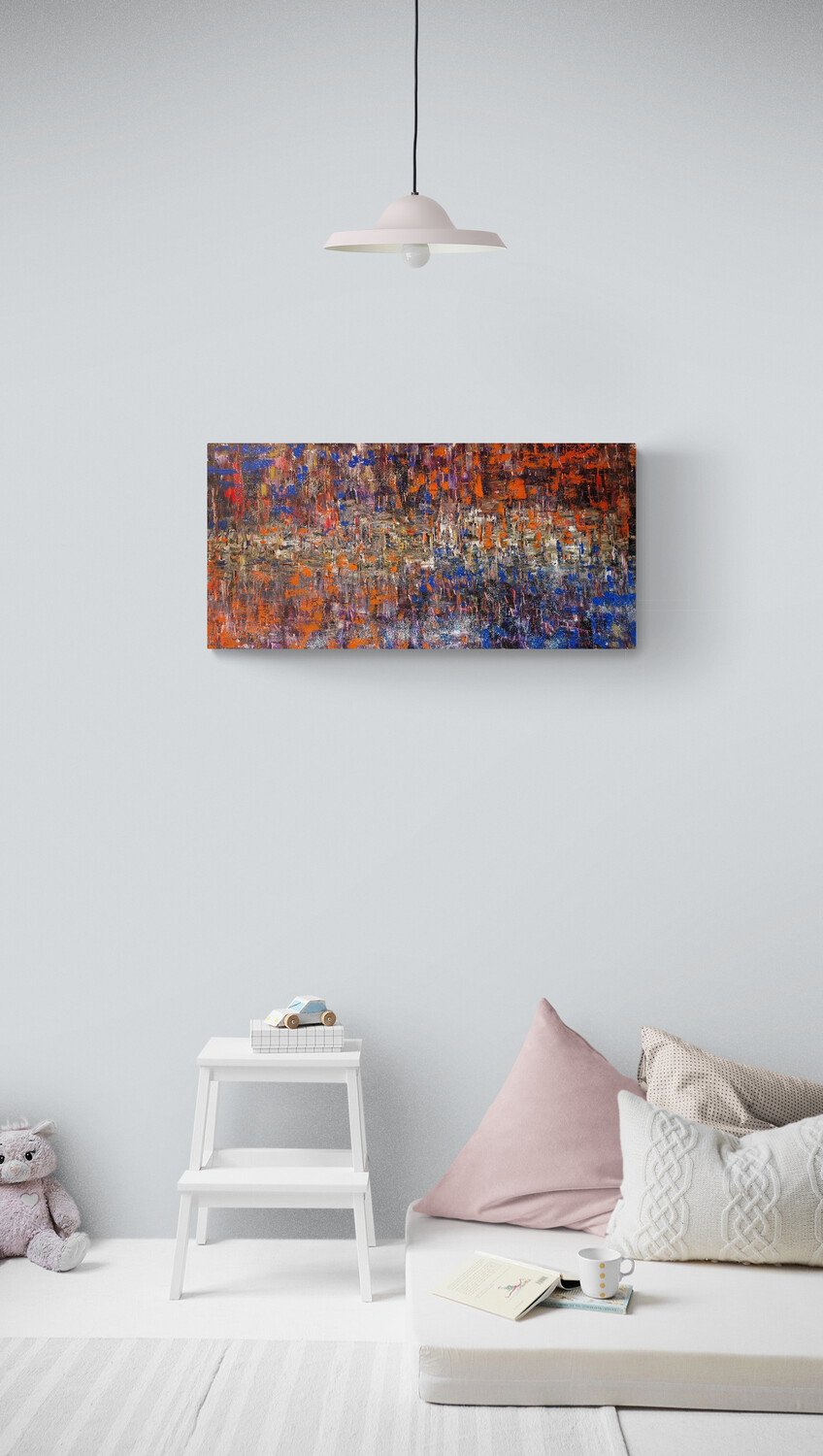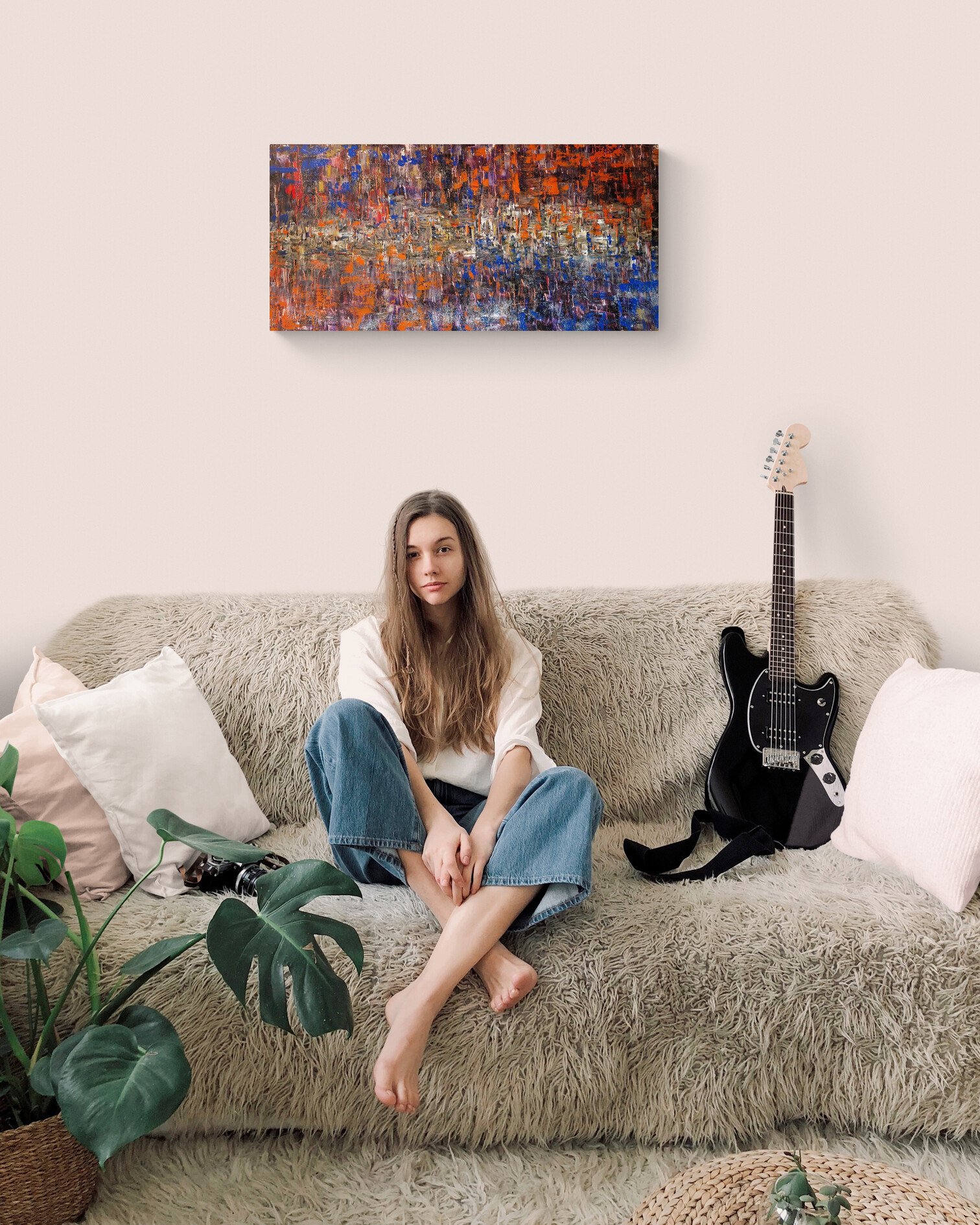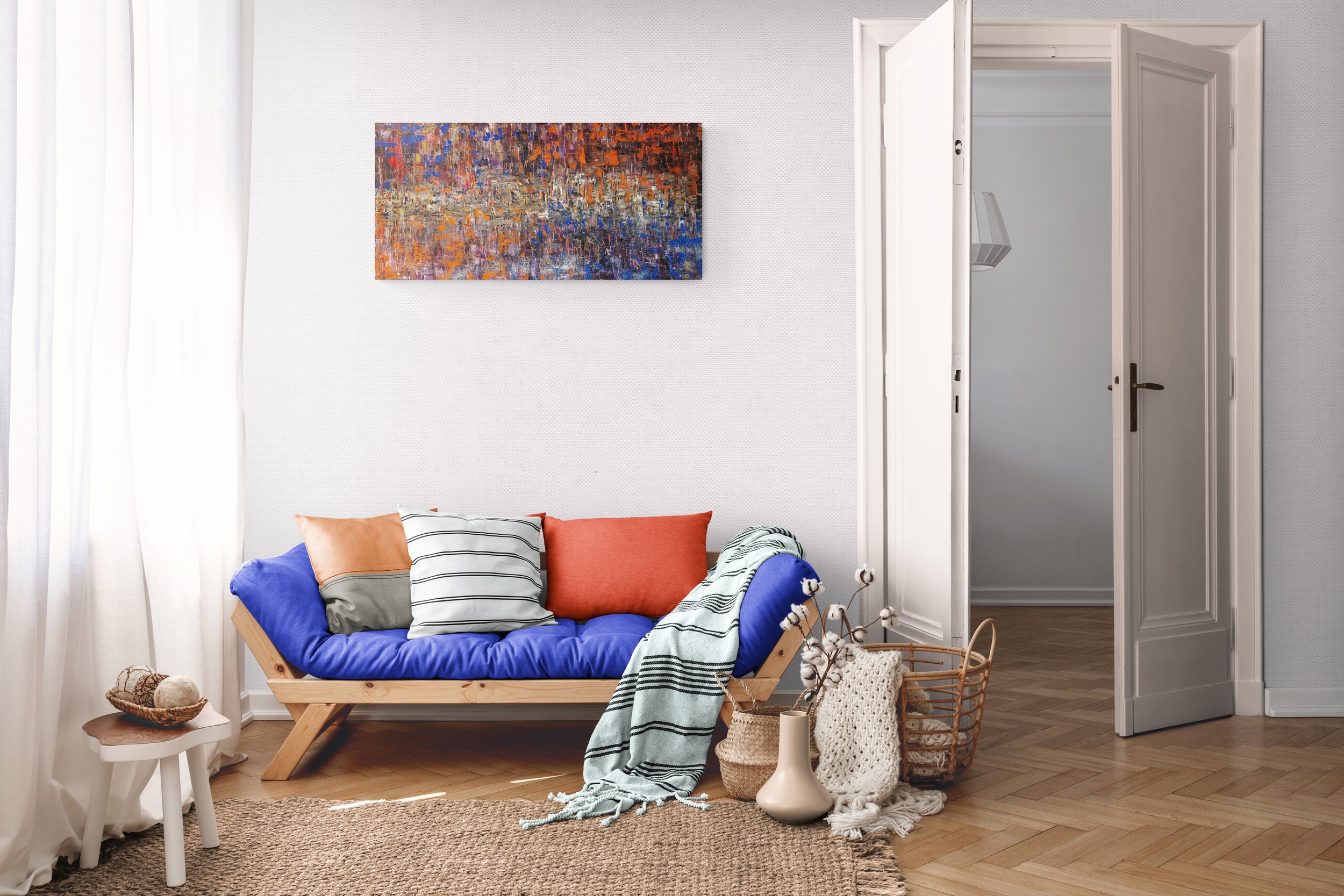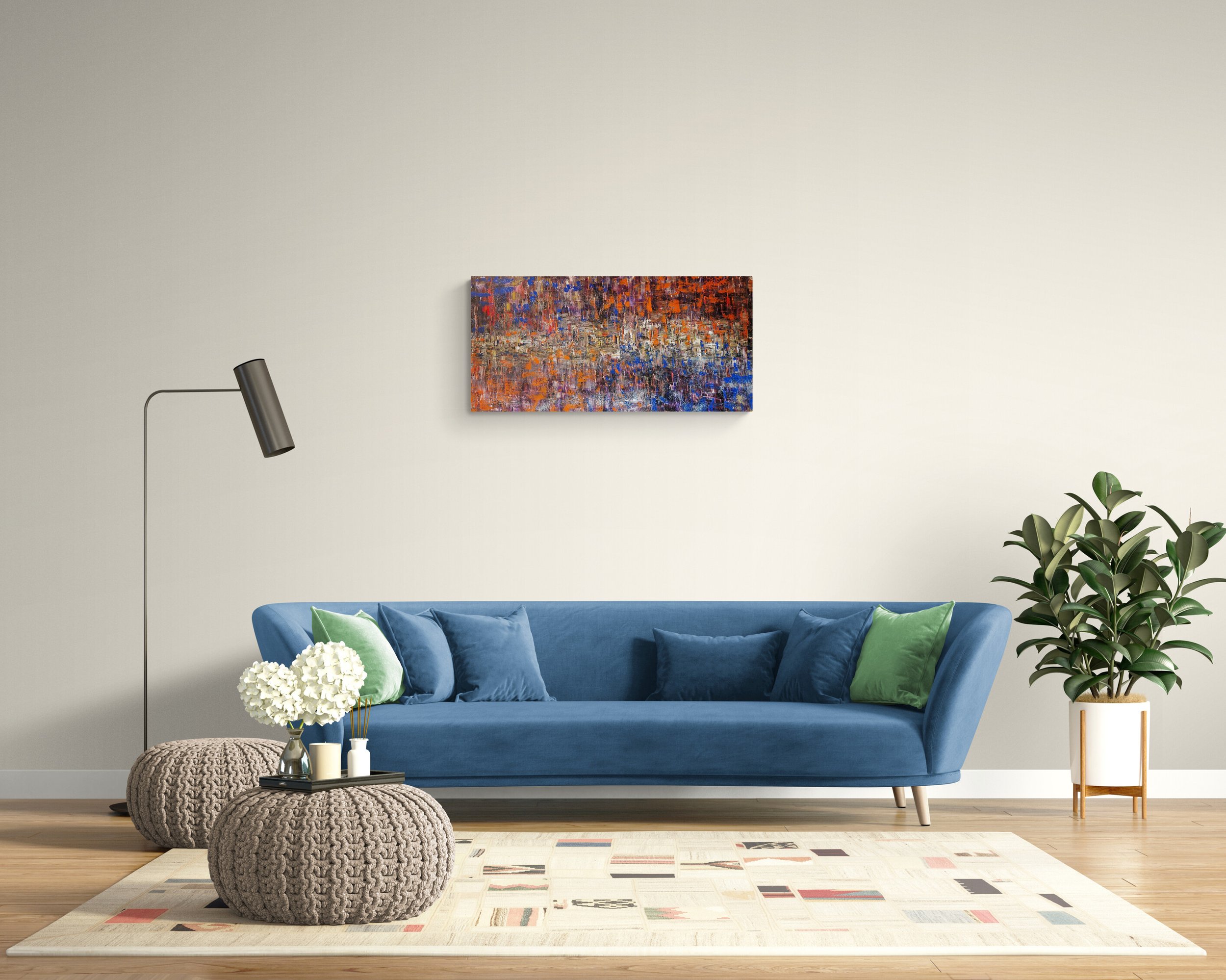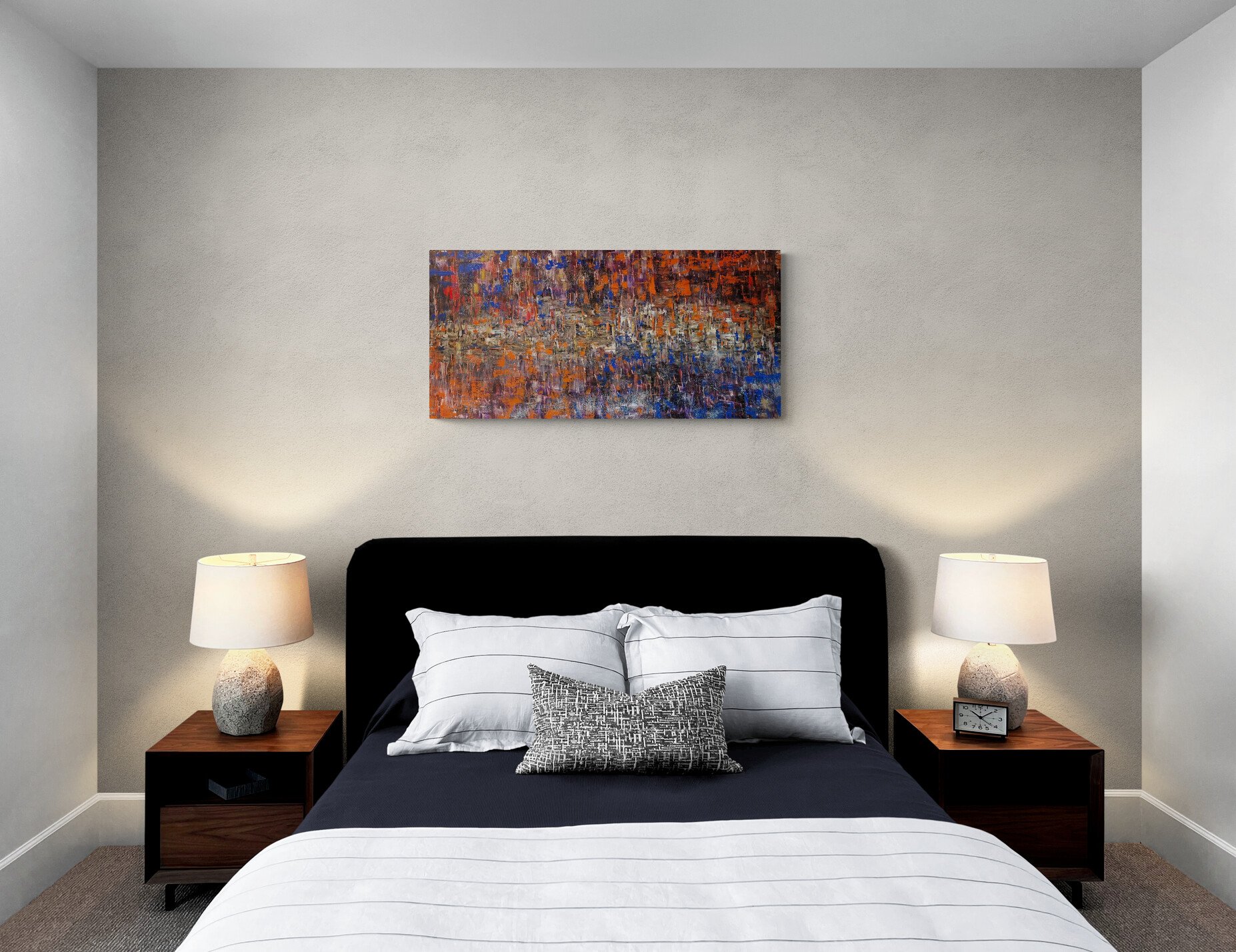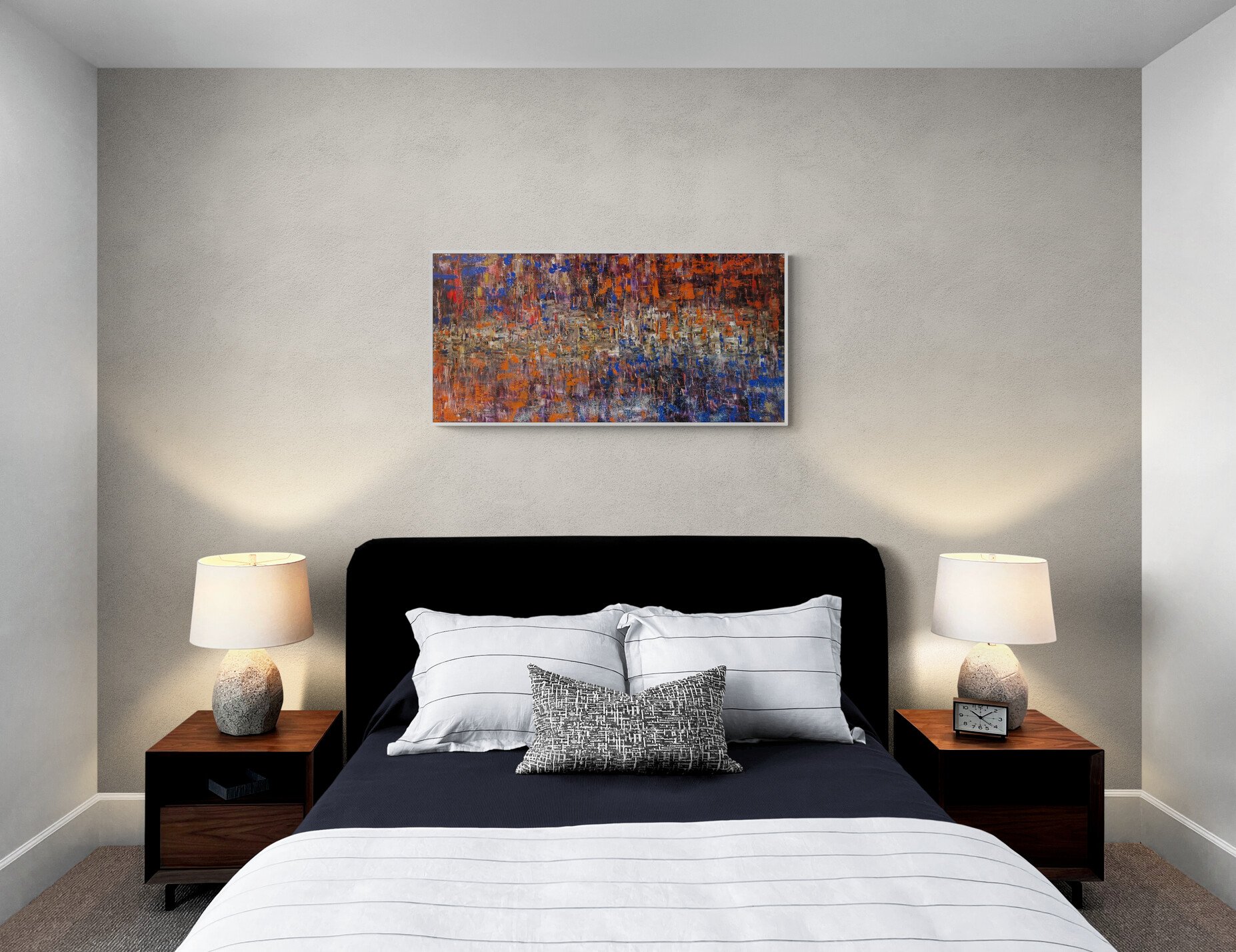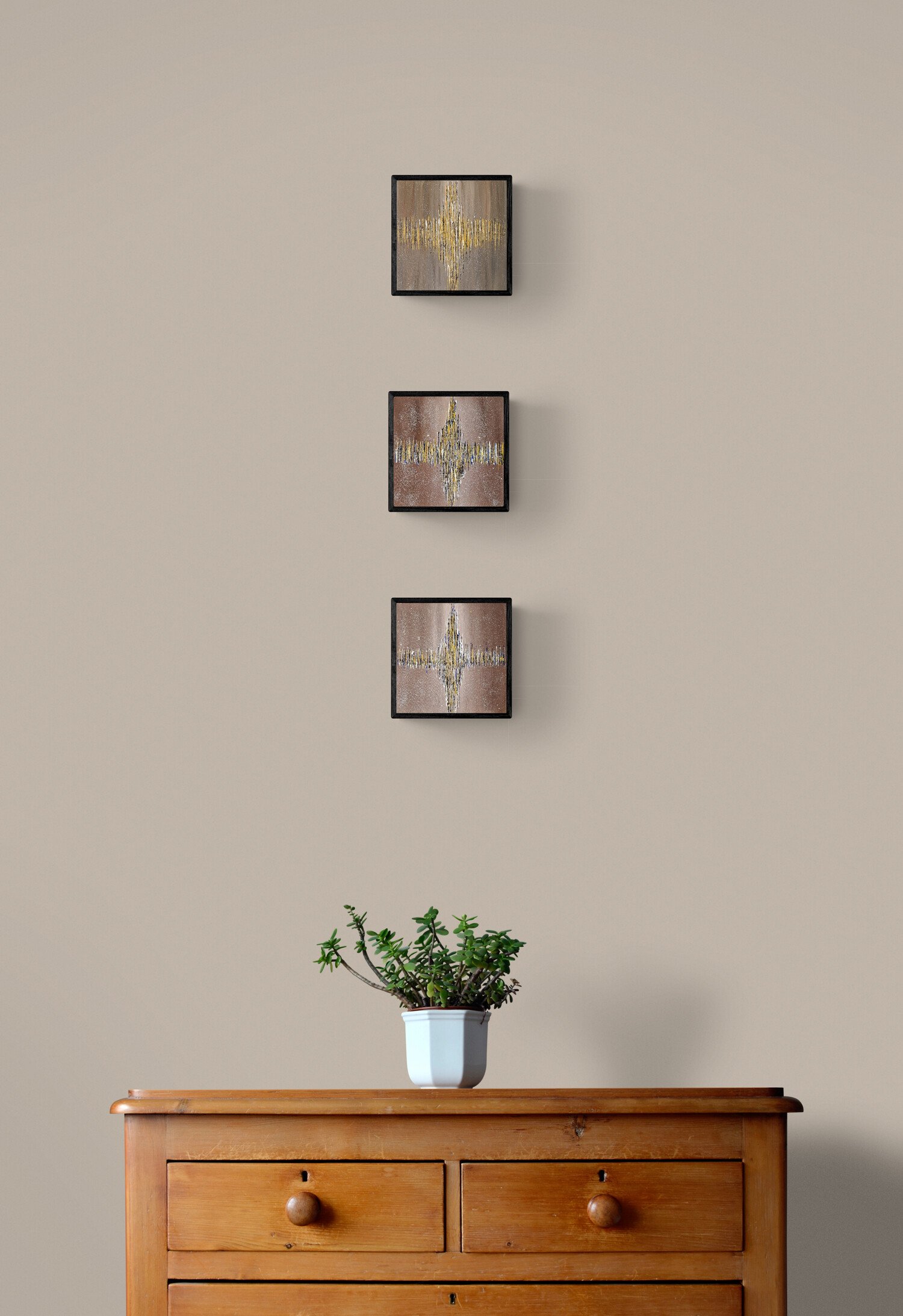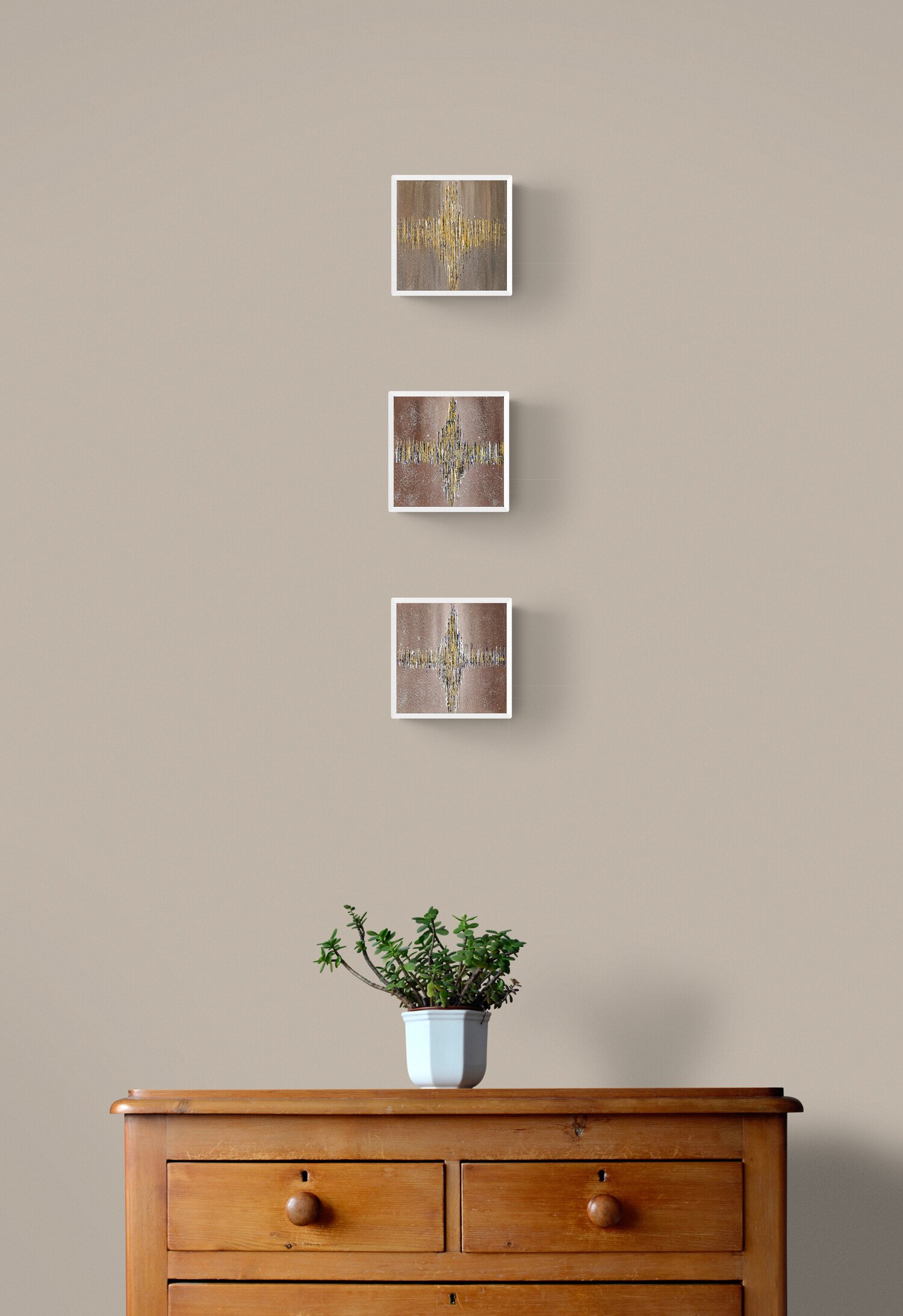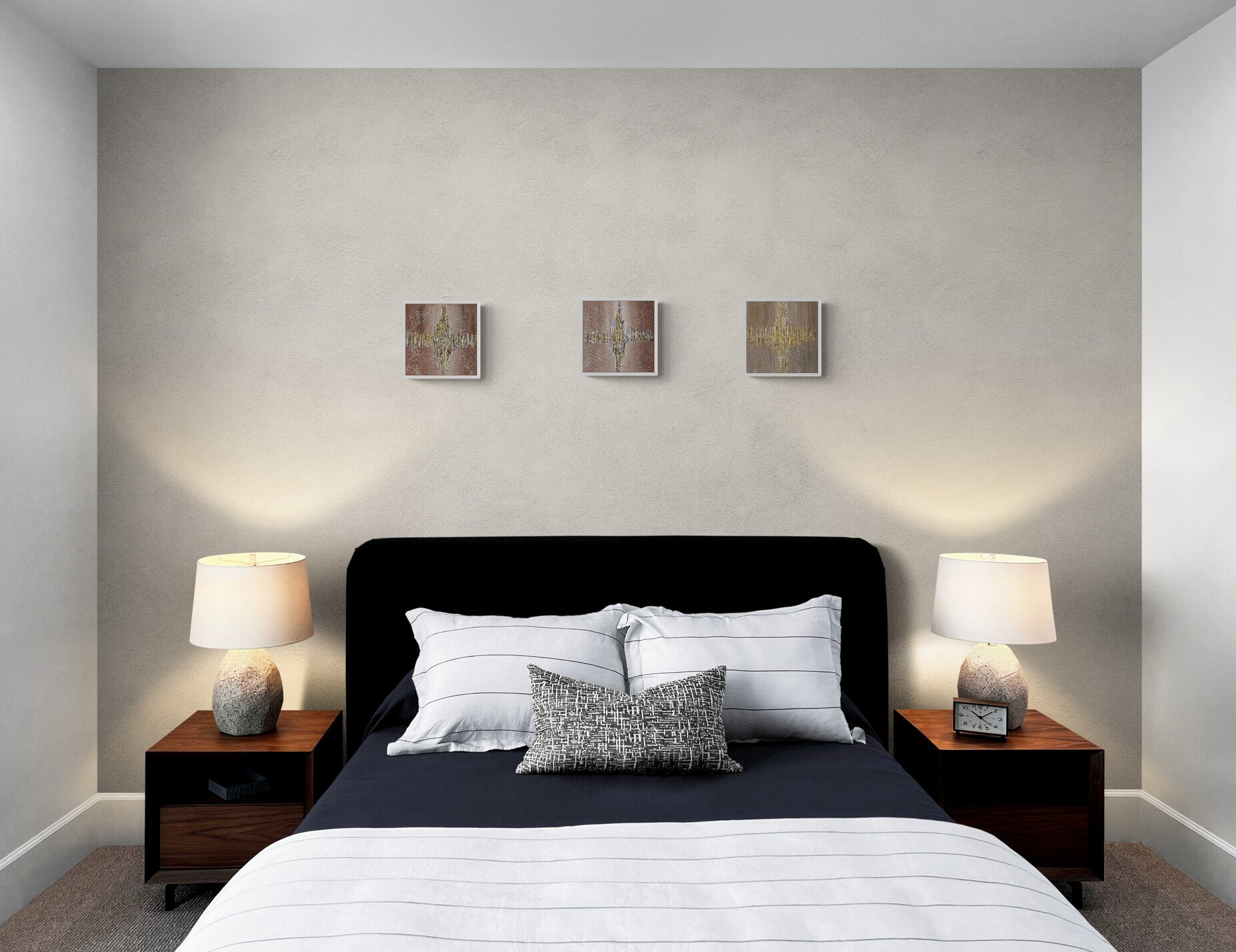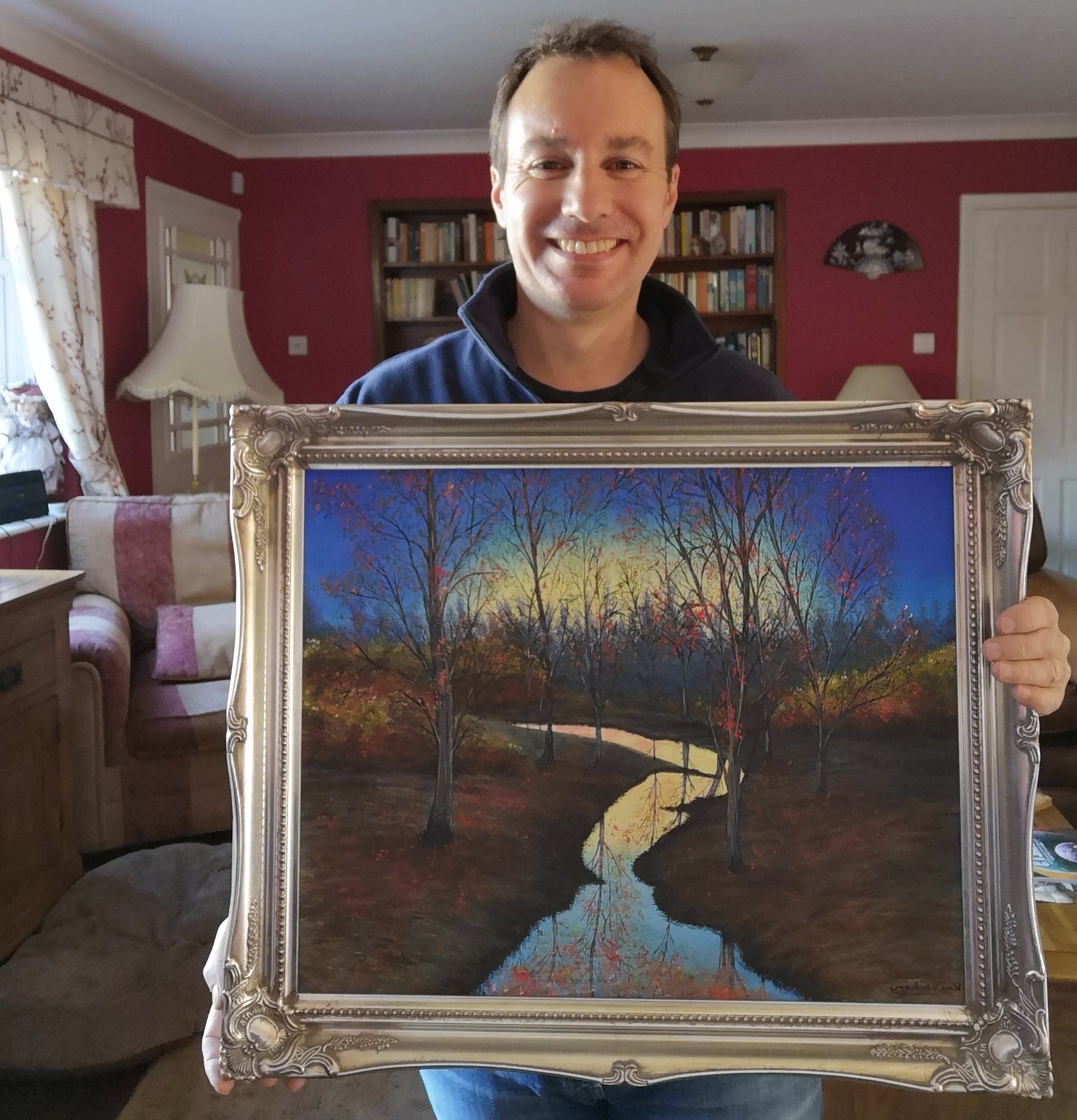Artful Escapes: Unravelling the Stories Behind My Paintings
Welcome to the world of abstract painting, where creativity knows no boundaries and self-expression takes centre stage. In this blog post, I will guide you through the process of creating the perfect abstract painting by harnessing your artistic instincts and exploring various techniques. We will delve into the essence of abstract art, discuss the key elements that contribute to its success, and provide insights into the techniques used by abstract artists.
It's been a while since we've delved into the vibrant world of my artistic creations (partly because I’ve been distracted with my novel writing and finishing my latest children’s book - always busy!), and I'm thrilled to bring you behind the scenes of my recent abstract series of paintings. In this edition, we'll embark on a journey to unravel the stories and inspirations woven into the kaleidoscopic tapestry of these unique paintings. Remember, I never repeat a painting and never create prints or copies of my work so each one is genuinely unique.
Genesis
At the heart of this series of paintings lies my fascination with the interplay of colours, the dance of hues carefully orchestrated to appear random yet inherently harmonious. This is all the more interesting to me because my colour vision is extremely limited, so I must employ a little help to ensure I get the balance exactly right. The seemingly arbitrary blocks of colour are, in reality, a meticulous selection designed to complement and contrast, injecting dynamism into the artwork. Have you ever wondered how your favourite colours might interact in an abstract composition?
I must be honest and confess that many years ago I really did not understand abstract art. I thought much of what I saw was simply random splashes of colour on a canvas, deliberately intended to provoke a reaction in the viewer. I could not see the skill involved or understand how much thought actually goes into examples of good abstract art (not all art is equal!). As I learned to become an artist and explore abstract art, I also learned to understand the truth. Good abstract art is far more complex than I had previously realised.
Texture as a Visual Symphony
I enjoy abstract art, but I think it can sometimes be a little one-dimensional. I like to see something dynamic and moving. This led me to begin exploring the realm of texture. In what may be considered a bold departure from conventional approaches, I introduced elements like modelling paste and other media to construct elevated lines and ridges within my paintings. This textural experimentation added a layer of intrigue, transforming the artwork dynamically under the play of light. Each piece becomes a living canvas, its appearance shifting with the angle and intensity of illumination. Can you visualize how the texture might change the way you experience the art in different lighting conditions?
Inspiration: Pushing Colors to the Edge
The driving force behind this series emerged from a personal challenge—to push the boundaries of colours without descending into chaos. It's a delicate balance, a nuanced dance where vibrant tones meet structured lines. The controlled chaos of colours converges with the ordered geometry of lines, resulting in a visual symphony that invites viewers to explore the depths within. How do you feel about the bold use of colours, and does it resonate with your own sense of aesthetics?
Creating Depth Through Structure
Structured lines serve as the backbone of this series, leading the viewer's eye through the intricate dance of colour. These lines, often horizontal and vertical, provide a framework that guides the visual experience. It's an exploration of organised chaos, where the structured and the spontaneous coexist in a harmonious dance. Can you identify the structured lines within the paintings, and do they draw your eye in a particular direction?
Viewers' Perspective
As I crafted each piece, I couldn't help but wonder how viewers would interpret and connect with these abstract compositions. The beauty of abstract art lies in its openness to interpretation, inviting each observer to bring their unique perspective to the canvas. I'm eager to hear about the emotions and stories these paintings evoke in you. What emotions do you feel when immersed in abstract art, and do you find your mind creating its own narratives?
Evolution of Style
This series marks a significant evolution in my artistic journey. The incorporation of texture and the bold use of colour represents a departure from earlier works, highlighting a continuous exploration and refinement of my creative style. What elements do you find yourself drawn to in other artists' work?
Engaging with Art
I like to think that art is a dialogue, a conversation between the creator and the audience. As you explore this series, I encourage you to not only observe but also engage. What resonates with you in this series? Is it the vibrant colours, the structured lines, or the texture that adds an extra layer of intrigue? Does this style really jar with you and, if so, tell me why?
This textured abstract art series encapsulates the essence of pushing artistic boundaries, a journey where colour, structure, and texture converge to create a visual feast. As you explore these abstract creations, I invite you to reflect on the interplay of chaos and order, spontaneity, and structure—a dance that mirrors the rich tapestry of life itself.
Until next time, keep discovering the beauty that lies within the strokes of colour and the dance of lines. I'd love to hear your thoughts and interpretations—drop a comment and let me know!
Exploring the Emotional Palette of Art - Why colour means so much to us
Colours - what a delightful language they speak! And they really do speak to us. They whisper stories, evoke feelings, and paint the canvas of our emotions. And what better place to start than understanding the very psychology of colours?
Welcome to this week’s edition of my newsletter. As you can see below, I have decided to embrace my new branding. I hope you like it. Let me know what you think. Today, we embark on a colourful journey, delving into the mesmerizing world of art and the emotions that swirl within its palette. Whether you're a seasoned art lover or just dipping your toes into the vivid ocean of creativity, join me as we unravel the secrets behind the shades that stir our souls (I think I’m becoming more poetic with each issue!).
Colours - what a delightful language they speak! And they really do speak to us. They whisper stories, evoke feelings, and paint the canvas of our emotions. And what better place to start than understanding the very psychology of colours?
The Psychology of Colors
Have you ever noticed how certain colours seem to tug at your emotions while others playfully dance on your senses? Colours have a remarkable ability to influence our moods and perceptions, a phenomenon rooted in colour psychology. Imagine walking into a room bathed in calming blues, or a space adorned with fiery reds—each hue carries its unique energy. Blues might instil a sense of tranquillity, while reds might ignite passion or excitement.
Nebula (sold) with its rich complementary colours.
As you explore the vast spectrum of emotions tied to colours, consider the colours that resonate with you personally. What shades make you feel alive, calm, or invigorated? Understanding this personal connection is like unlocking a secret door to your own emotional landscape.
You may not think colour theory is something that affects you, but I promise it does and you didn’t even realise it. There is an entire industry built around the psychology of colour and how it affects consumer behaviour. Manufacturers, supermarkets and even clothes designers spend a fortune working with experts who understand colour and how it influences how and what we buy. Don’t believe me? Read this insightful article and then look around you at the things you’ve bought. Colour theory and colour psychology are everywhere.
Emotive Hues
Let's take a plunge into the ocean of emotive hues. The spectrum is vast, ranging from the serene blues and greens that echo nature's calming embrace to the passionate reds and yellows that ignite the flames of energy. Each colour tells a story, and every shade carries its own emotional weight.
Consider the calming allure of greens—nature's embrace in a myriad of hues from deep emerald to vibrant lime. Greens often signify growth, balance, and renewal. Now, imagine the fiery embrace of reds and oranges. These warm hues can evoke feelings of passion, energy, and even urgency.
As we explore this emotional spectrum, take a moment to think about the colours that dominate your surroundings. Are you surrounded by the soothing coolness of blues and purples, or does your space pulse with the warm energy of reds and oranges?
Creating Mood with Colours
Now, let's talk about the magical art of creating a mood with colours. Artists, much like sorcerers of the visual realm, use colours to evoke specific emotions and atmospheres within their work. Picture a sunset painting awash in warm oranges and pinks—doesn't it instantly transport you to a serene, dreamy landscape?
When visiting an art gallery or perusing artwork online, pay attention to the colours that resonate with you. Are you drawn to the calming pastels that evoke a sense of nostalgia, or do you find yourself captivated by bold, contrasting hues that demand attention? Your preferences are your artistic fingerprint, guiding you to the pieces that speak to your soul.
In the vibrant tapestry of art, colours are the threads that weave stories and stir emotions. So, what colours speak to you, and how do they shape the canvas of your emotions?
Now, this is a newsletter to also entice you into looking at my artwork so why not explore more captivating colours and emotions by visiting awberyart.com and immerse yourself in a spectrum of emotions? From tranquil blues to passionate reds, each artwork is a brushstroke in the colourful narrative of emotions (well, I like to think so). Dive into the collection and discover pieces that resonate with your unique palette of feelings. Which paintings strike a chord with you and why? Let me know in the comments.
Unleashing Your Creativity: A Guide to Creating the Perfect Abstract Painting
Welcome to the world of abstract painting, where creativity knows no boundaries and self-expression takes centre stage. In this blog post, I will guide you through the process of creating the perfect abstract painting by harnessing your artistic instincts and exploring various techniques. We will delve into the essence of abstract art, discuss the key elements that contribute to its success, and provide insights into the techniques used by abstract artists.
Introduction
Welcome to the world of abstract painting, where creativity knows no boundaries and self-expression takes centre stage. In this blog post, I will guide you through the process of creating the perfect abstract painting by harnessing your artistic instincts and exploring various techniques. We will delve into the essence of abstract art, discuss the key elements that contribute to its success, and provide insights into the techniques used by abstract artists.
How to Create the Perfect Abstract Painting
Creating a captivating abstract painting requires a unique blend of spontaneity, intuition, and intention. While there are no rigid rules to follow, the following steps can guide you in your artistic journey:
Embrace spontaneity and intuition
Abstract painting is a realm of artistic freedom where you can let go of the need for perfection. Allow your instincts to guide your brush, embracing the fluidity and unpredictability of the creative process. Trust your inner voice and take bold leaps into the unknown.
Start with a concept or inspiration
Though abstract art doesn't aim to represent tangible objects, having a concept or inspiration in mind can provide a starting point for your artistic exploration. It could be a particular feeling, a memory, or even a specific colour palette that resonates with you. This initial spark will serve as a guiding force as you embark on your abstract painting journey.
Experiment with composition
Composition is a fundamental aspect of abstract art. Consider the placement of shapes, lines, colours, and textures within the canvas. Explore different arrangements, proportions, and perspectives to find a balance that conveys the desired energy and visual impact. Allow the composition to evolve organically as you interact with the canvas.
Making a Good Abstract Painting
While there are no strict rules for abstract painting, certain elements and techniques can enhance the quality of your artwork. Here are some key factors to consider:
Engage with colour theory
Colours hold immense power in abstract art. Experiment with different colour combinations to evoke specific emotions or create a harmonious balance. Dive into the realm of colour theory, understanding the psychological effects of different hues and their interactions. Use colours purposefully to enhance the overall impact and create a captivating visual experience.
Use varied textures
Texture adds depth and intrigue to abstract paintings. Experiment with techniques like layering, impasto, or glazing to create texture and tactile elements. Building up layers of paint or incorporating other materials can add dimension and complexity to your artwork, captivating the viewer's senses.
Establish a focal point
While abstract art does not rely on recognizable subjects, having a focal point can anchor the viewer's attention and create visual interest within your painting. It could be a particular shape, colour, or area that stands out from the rest of the composition. Use contrasting elements or techniques to draw the viewer's eye towards the focal point, creating a sense of intrigue and engagement.
Are there rules for abstract painting?
Abstract painting liberates you from the constraints of traditional rules, allowing you to explore your artistic vision freely. However, there are guiding principles that can enhance your abstract artistry:
Balance and harmony
Strive for a sense of balance and harmony within your composition. Distribute visual weight evenly, considering the placement of elements and their relationship to one another. Achieving a harmonious balance will create a cohesive and aesthetically pleasing artwork.
Experimentation and exploration
Abstract art thrives on experimentation and pushing boundaries. Embrace unconventional techniques, materials, and approaches to create unique and intriguing artwork. Challenge yourself to explore new territories and uncover hidden depths of your creativity.
Authenticity and personal expression
Abstract painting provides a platform for personal expression. Avoid trying to mimic other artists' styles and focus on developing your own artistic identity. Embrace your unique perspective and let your artwork reflect your authentic self. Unleash your emotions, thoughts, and experiences onto the canvas.
What are the 6 key elements to abstract art success?
To achieve success in abstract art, consider these six key elements:
Composition: The arrangement of shapes, lines, colours, and textures within the artwork plays a vital role in its visual impact. Experiment with different compositions, exploring the interplay between various elements to create a visually appealing and balanced artwork.
Colour: Colours have the power to evoke emotions and set the mood of your artwork. Explore different colour palettes, combinations, and contrasts. Consider the psychological effects of colours and use them purposefully to enhance the overall impact of your abstract painting.
Texture: Texture adds depth and tactile interest to your artwork. Experiment with techniques such as layering, brushwork, or mixed media to create varied textures that engage the viewer's senses. Incorporate elements that invite touch and exploration.
Contrast: Contrast adds visual interest and helps create focal points within your abstract painting. Experiment with contrasting colours, shapes, or textures to create dynamic compositions. The interplay between light and dark, smooth and rough, or bold and subtle can heighten the impact of your artwork.
Movement: Abstract art often conveys a sense of movement or energy. Explore the use of lines, shapes, and brushstrokes to create a sense of flow and rhythm within your painting. Consider the direction and velocity of your marks to evoke a dynamic visual experience.
Emotional resonance: Abstract art has the ability to evoke emotions in the viewer. Aim to create artwork that resonates emotionally, whether through the use of colour, composition, or personal expression. Infuse your artwork with your unique perspectives and experiences, allowing the viewer to connect with the emotions conveyed in your abstract painting.
Techniques Used by Abstract Artists
Abstract artists employ a variety of techniques to create their unique artworks. Here are some commonly used techniques:
Layering
Building up layers of paint adds depth and complexity to your artwork. Experiment with transparent and opaque layers to achieve desired effects. Each layer interacts with the previous ones, creating a rich and visually engaging surface.
Brushwork
The choice of brushes and brushstrokes can add texture, expressiveness, and movement to your abstract painting. Vary the brush sizes, angles, and pressure to create a range of effects, from delicate and controlled to bold and expressive.
Pouring and dripping
Pouring or dripping paint onto the canvas can result in spontaneous and organic patterns. This technique allows for chance and serendipity in the creation process, leading to surprising and captivating results.
Collage and mixed media
Incorporating different materials, such as paper, fabric, or found objects, can add texture, dimension, and visual interest to your abstract artwork. Experiment with layering various materials to create unique and compelling compositions.
Sgraffito
Scratching or scraping the surface of the painting can reveal underlying layers and create intriguing textures. Use tools like palette knives or the end of a brush to scrape away paint, adding depth and visual interest to your abstract artwork.
Conclusion
Abstract painting is an exhilarating journey of self-expression and creative exploration. By embracing spontaneity, experimenting with composition, engaging with colour theory, and exploring various techniques, you can unlock your artistic potential and create captivating abstract art. Remember, there are no limits to your creativity in the abstract realm. Embrace the freedom, follow your intuition, and let your artwork reflect the depths of your imagination.
Embracing the Artist Within: Balancing Work and Creative Passions
In the fast-paced world we live in, finding a balance between work and personal pursuits can be challenging. As a scientist with a full-time job, I understand the importance of maintaining a good work-life balance. While you may be interested in my art and book writing rather than my day job, I believe that striking a harmonious equilibrium between professional responsibilities and personal passions is key to living a fulfilling and enriched life. In this blog post, I'll share my journey and provide practical tips on how I manage to pursue my creative endeavours alongside my demanding career.
Introduction
In the fast-paced world we live in, finding a balance between work and personal pursuits can be challenging. As a scientist with a full-time job, I understand the importance of maintaining a good work-life balance. While you may be interested in my art and book writing rather than my day job, I believe that striking a harmonious equilibrium between professional responsibilities and personal passions is key to living a fulfilling and enriched life. In this blog post, I'll share my journey and provide practical tips on how I manage to pursue my creative endeavours alongside my demanding career.
Introduction
In the fast-paced world we live in, finding a balance between work and personal pursuits can be challenging. As a scientist with a full-time job, I understand the importance of maintaining a good work-life balance. While you may be interested in my art and book writing rather than my day job, I believe that striking a harmonious equilibrium between professional responsibilities and personal passions is key to living a fulfilling and enriched life. In this blog post, I'll share my journey and provide practical tips on how I manage to pursue my creative endeavours alongside my demanding career.
Discovering My Creative Passions
For me, the journey into art and book writing began with a desire to explore new hobbies and indulge in learning new things. It was a thoughtful gift from my wife—a watercolor set—that sparked my interest in art, while my love for writing was nurtured through years of journaling. These creative outlets became an essential part of my life, allowing me to escape the demands of work and express my inner thoughts and emotions.
Time Management
To make room for my artistic pursuits, I prioritize efficient time management. I mark out my working day calendar, ensuring that I typically finish work by 4pm. This allows me to create clear boundaries between my professional and personal time. Calendar blocking has been a game-changer for me—I allocate specific time slots for meetings, emails, and other work-related tasks, as well as dedicated blocks in the evenings for my writing, planning, painting, and engaging with social media and marketing efforts.
Transitioning from Work to Creativity
Transitioning from the demands of my day job to the realm of creativity requires a deliberate mindset shift. Taking 30 minutes to wind down after work helps me decompress and mentally prepare for my creative projects. Additionally, I find it essential to have separate spaces for different activities. While my office serves as a workspace for my day job, I've designated a separate desk for writing, complete with a mood board for inspiration, and a dedicated studio space for my paintings. This compartmentalization helps my brain recognize which activity I'm focusing on and allows for smoother transitions.
Setting Boundaries
Creating a healthy work-life balance also means setting boundaries and avoiding work-related distractions during personal creative time. After 4pm, I intentionally disconnect from work by not having my work laptop or mobile phone accessible. This practice ensures that I can fully immerse myself in my artistic pursuits without the intrusion of work-related matters.
Finding Inspiration
Inspiration can be found in the world around us. As an observant person, I draw inspiration from my surroundings, incorporating what I see and hear into my writing and artwork. I also seek inspiration from online resources, such as videos and blogs by inspirational artists and writers. Engaging with their work sparks my creativity and fuels my passion for continuous growth.
Prioritization and Goal-Setting
Lists are my trusted allies in maintaining focus and prioritizing my creative endeavors. I keep a list of long-term goals for both my work and my artistic pursuits, breaking them down into manageable weekly and daily objectives. This approach ensures that I dedicate time to writing blog posts regularly and creating new artwork consistently. By organizing my goals, I am able to balance my professional responsibilities with my personal passions effectively.
The Crossroads of Work and Creativity
Embracing creative outlets alongside my scientific career has brought numerous benefits into my life. Engaging in art and writing expands my mind, constantly challenging me to learn and grow. These pursuits not only provide me with personal fulfillment but also offer unexpected advantages in my day job. Developing writing skills has improved my formal report writing, while my knowledge of social media has enhanced my presentation abilities. The intersection between my personal interests and professional life has created a dynamic synergy, benefiting both aspects of my life.
Final Thoughts and Advice
To those struggling to find time for their own creative passions, my advice is to evaluate the free time available and make conscious choices. Eliminating or reducing time spent on activities like excessive TV-watching can free up valuable hours for meaningful and enjoyable pursuits. Remember, balance is achievable with careful planning and prioritization. Embrace your passions, allocate time mindfully, and witness the transformative power of creative expression.
Maintaining a healthy work-life balance is a continuous journey that requires intention and effort. As a scientist with a love for art and writing, I've learned that dedicating time to my creative passions not only enriches my personal life but also enhances my professional growth. By implementing strategies like effective time management, setting boundaries, finding inspiration, and prioritizing goals, I've been able to strike a harmonious balance between my day job and my artistic pursuits. Embrace your inner artist and create a life where work and creativity coexist in harmony—it's an incredible journey worth embarking on.
Thank you for reading Roy P. Awbery Fine Art. This post is public so feel free to share it.
The Power of Daily Sketching: Unleashing Your Creativity
Welcome to my blog, where I dive into the incredible benefits of daily sketching and drawing. Whether you consider yourself an artist or not, incorporating sketching into your daily routine can have a profound impact on your creativity and personal growth. As I explore different subjects and experiment with various techniques, I discover new ideas and perspectives. Sketching enhances my observation skills, allowing me to appreciate the intricate details of the world around me. It also provides a meditative experience, where I can unwind and embrace mindfulness. Through this blog, I invite you to join me on this journey of self-expression, creativity, and exploration. Let's start sketching every day and witness the transformative power it holds to unleash our inner artist and foster personal growth.
Introduction
I’ve sketched for as long as I can remember. I can’t say I was ever particularly good at it and I never researched the subject in my youth (I wish I had now). Over the years, I have found that I mainly sketched to relax. In our fast-paced world, I think taking time for self-expression and creativity is often overlooked, especially when I see so many people ‘relaxing’ with their phones! However, engaging in a daily sketching or drawing practice can have transformative effects on your life. Whether you consider yourself an artist or not, the act of putting pen to paper holds incredible potential. Here are some compelling reasons why you should make sketching or drawing a part of your daily routine. Trust me, if you get started you won’t regret it and you never know where it may take you.
1. Unlocking Creative Potential
Creativity is a fundamental aspect of the human experience. Engaging in daily sketching exercises helps you tap into your creative potential. For example, you can dedicate a small portion of your day to sketching a random object you find at home or capturing a moment from your surroundings. By exploring different subjects, experiment with colours and lines, and push your artistic boundaries, you'll discover new ideas and perspectives.
If you want to get started, create a dedicated space for your sketching practice, free from distractions. You should, if possible, set aside a specific time each day to sketch, even if it's just for a few minutes - it will help relax you. Perhaps use it as part of your end-of-day wind down process. Don’t be afraid to experiment with different mediums, such as pencil, pen, charcoal, or watercolour, to keep your practice fresh and exciting.
Recommended Reading: "The Artist's Way" by Julia Cameron provides valuable insights and exercises to unleash your creativity and overcome creative blocks.
2. Enhancing Observation Skills
Sketching trains your eye to see the world more attentively. By focusing on the details of your subject, you become more observant of the intricacies and nuances in your surroundings. You can start by sketching everyday objects in your home, such as a coffee mug, a potted plant, or a piece of fruit. Pay close attention to their shape, texture, and lighting.
Of course, you can also combine your other daily routines with sketching, for example:
Take regular walks where you live and sketch interesting scenes or objects you encounter.
Practice sketching from life whenever possible, as it allows you to observe and capture the unique characteristics of your subject.
Experiment with different sketching techniques, such as contour drawing, cross-hatching, or gestural sketching, to further develop your observational skills.
Recommended Reading: "The Zen of Seeing: Seeing/Drawing as Meditation" by Frederick Franck explores the connection between art and meditation, emphasizing the importance of observation in the creative process.
3. Practicing Mindfulness and Relaxation
Engaging in sketching or drawing provides a meditative experience that promotes mindfulness and relaxation. When you immerse yourself in the act of drawing, you enter a state of flow, where time seems to dissolve, and you're fully present in the moment. To enhance this experience, consider sketching natural scenes, such as landscapes or flowers, allowing yourself to connect with the tranquillity of the environment.
Suggestions for Success:
Create a calming atmosphere by playing soft music or lighting candles while you sketch.
Practice deep breathing exercises before and during your sketching session to centre yourself and enhance relaxation.
Embrace imperfections and focus on the process rather than solely on the end result. Sketching is about the joy of creation and self-expression.
Recommended Reading: "Drawing on the Right Side of the Brain" by Betty Edwards offers valuable insights into the creative process and how drawing can enhance mindfulness and self-expression.
4. Tracking Personal Growth and Progress
Daily sketching allows you to document your artistic journey over time. By committing to regular practice, you can witness your progress first-hand. Consider keeping a sketchbook dedicated to your daily sketches, allowing you to look back on your earlier drawings and compare them to your present work. Celebrate your improvement and recognize how far you've come as an artist.
I have tons of Moleskine sketch books, which although not cheap are high quality, but you could use any notebook you can find. As you begin recording your sketches be sure to date each sketch in your sketchbook to keep track of your progress and don't be afraid to experiment and take risks in your sketches. Push yourself out of your comfort zone to foster growth and development. If you’re brave enough, seek constructive feedback from friends or artists you may know or join online communities where you can share your work and receive encouragement.
Recommended Reading: "Steal Like an Artist: 10 Things Nobody Told You About Being Creative" by Austin Kleon encourages embracing the influence of others while maintaining your unique artistic voice.
5. Enhancing Visual Communication Skills
Visual communication is a powerful tool that transcends language barriers. Through sketching or drawing, you develop the ability to convey ideas, emotions, and narratives visually. To enhance your visual communication skills, consider sketching people, capturing their expressions and gestures, or creating visual stories through sequential art.
If you get really into sketching then you could also try the following ideas to help you improve:
Experiment with different composition techniques to create visual impact and guide the viewer's attention.
Study the work of artists known for their storytelling abilities, such as graphic novelists or storyboard artists, to learn effective visual narrative techniques.
Practice simplifying complex concepts into visual representations, such as diagrams or infographics, to improve your ability to communicate ideas concisely.
Recommended Reading: "Visual Thinking: Empowering People and Organizations through Visual Collaboration" by Willemien Brand provides insights into the power of visual thinking and communication in professional and personal settings.
6. Cultivating Self-Expression and Personal Style
Sketching regularly enables you to explore and develop your unique artistic style. As you experiment with different techniques, materials, and subjects, you discover what resonates with you and what makes your work distinct. Embrace this journey of self-discovery and allow your sketches to be a reflection of your thoughts, feelings, and experiences.
Suggestions for Success:
Study the work of various artists, both traditional and contemporary, to expose yourself to different styles and approaches.
Keep a collection of images, objects, and ideas that inspire you and refer to them when seeking inspiration for your sketches.
Experiment with different mediums, styles, and subjects to find what resonates with you and allows you to express yourself authentically.
Recommended Reading: "The Creative License: Giving Yourself Permission to be the Artist You Truly Are" by Danny Gregory encourages embracing your artistic voice and finding inspiration in everyday life.
Conclusion
Sketching or drawing every day offers a myriad of benefits that extend beyond the realm of art. From unlocking your creative potential to improving observation skills, promoting mindfulness, enhancing visual communication, tracking personal growth, and cultivating self-expression, the power of this simple practice is undeniable. So, grab a sketchbook and a pencil, and embark on a journey of self-discovery, growth, and artistic expression. Make sketching a part of your daily routine and witness the transformative effects it can have on your life.
If you do get started, feel free to show me your creations. I started out sketching years ago and it eventually led me to becoming a successful semi-professional artist. Who knows where it may take you?
How to Choose the Right Artwork for Your Home
I believe that art has the power to transform and enhance the ambience of any living space. In this post, '’ll guide you through the process of choosing the perfect artwork for your home. Discover how to find pieces that resonate with your personal style and create a harmonious environment that truly reflects who you are.
Introduction
Welcome to my blog! I believe that art has the power to transform and enhance the ambience of any living space. In this post, '’ll guide you through the process of choosing the perfect artwork for your home. Discover how to find pieces that resonate with your personal style and create a harmonious environment that truly reflects who you are. If you have any questions or need personalized advice, don't hesitate to reach out to me. I’m here to help!
Understanding Personal Style
Your personal style is unique, and art should reflect that. Take some time to explore different art styles, from abstract and contemporary to impressionistic or minimalistic. Visit local galleries, browse online art platforms, and immerse yourself in various artistic expressions. Pay attention to what captures your attention and stirs emotions within you. Do you find yourself drawn to bold and vibrant colours, or do you prefer softer, more muted tones? Are you captivated by intricate details or more intrigued by simplicity? Understanding your personal style will help you curate a collection that speaks to your heart.
Consider the Space
When choosing artwork for your home, it's essential to consider the space in which it will be displayed. Analyze the available wall space and take note of the dimensions. In larger rooms, bold and statement pieces can make a powerful impact, while smaller spaces may benefit from smaller or medium-sized artworks. Experiment with different orientations, such as horizontal, vertical, or square, to find the best fit for each room. For example, a tall and narrow wall may benefit from a vertical piece that emphasizes the height, while a wide and spacious wall could accommodate a larger horizontal artwork that creates a focal point. Consider the overall layout of the room and how the artwork will interact with other elements. By carefully considering the space, you can choose artwork that not only fits well but also enhances the overall aesthetic and atmosphere of the room.
Harmonizing Colors and Themes
Add abstract art by Roy P. Awbery to your home decor.
Colours have the power to create a harmonious and visually pleasing environment. When selecting artwork, consider the existing color scheme of your space, including the walls, furniture, and decor. Choose artwork that complements or introduces new colors to enhance the overall ambiance. For instance, if your space features warm earth tones, consider artwork with complementary colors like blues or greens to create an intriguing contrast. Additionally, align the themes and subject matter of the artwork with the overall theme or vibe of the room. If you have a coastal-themed living room, artwork depicting seascapes or beach scenes can bring a sense of serenity and connection to the space. Pose questions to yourself: How can the colors and themes of the artwork enhance the atmosphere you want to create? What emotions or feelings do you want the artwork to evoke? By carefully considering the colors and themes, you can curate a collection that not only looks visually stunning but also resonates with the overall ambiance and personality of your home.
Finding the Right Balance
Integrating artwork into your space requires finding the right balance. Consider the interplay between artwork, furniture, and other decor elements. Create a focal point by placing a captivating piece in a prominent position, such as above a fireplace or at the centre of a gallery wall. Allow the artwork to guide the arrangement of other decorative items, ensuring a harmonious and visually pleasing composition. Experiment with different arrangements and groupings to find the perfect balance that highlights both the individual artwork and the overall aesthetic of the room. Take a moment to step back and assess the visual balance—does the artwork draw your eye in without overwhelming the other elements in the space? Remember that balance doesn't necessarily mean symmetry; it can be achieved through the careful placement of different elements to create visual harmony. Challenge yourself to think creatively: How can you arrange the artwork to create an interesting flow? What other elements in the room can complement and enhance the presence of the artwork? By finding the right balance, you can create a space that feels cohesive, visually engaging, and inviting.
Exploring Artistic Mediums
Artistic mediums offer unique qualities and visual effects that can significantly impact the atmosphere of a room. Paintings, prints, sculptures, and photography each bring a distinct character to a space. Explore different mediums and experiment with textures, materials, and finishes to add depth and variety to your collection. Consider the impact of a large-scale abstract painting, the intricate details of a handcrafted sculpture, or the captivating storytelling of a photographic print. Each medium carries its own expressive power and can evoke different emotions and moods. Pose questions to yourself: How do you want the artwork to interact with the surrounding space? Do you want a three-dimensional piece that adds depth and dimension, or a two-dimensional artwork that adds a splash of color and texture? By exploring different artistic mediums, you can find the perfect combination that resonates with your personal style and elevates the visual appeal of your home.
Seeking Authenticity and Meaning
When choosing artwork for your home, seek pieces that hold authenticity and meaning. Investing in authentic artwork or limited-edition prints adds value and significance to your collection. These pieces not only reflect your unique style but also support artists and their creative journeys. Take the time to connect with artwork that resonates with you on a deeper level, evoking emotions and telling stories that align with your personal narrative. Challenge yourself to think beyond mere aesthetics and consider the deeper meaning behind each piece. Does the artwork evoke memories or experiences? Does it convey a specific message or evoke certain emotions? By seeking authenticity and meaning, your collection becomes more than just decorative pieces—it becomes a reflection of your values, passions, and personal journey.
Conclusion
Choosing the perfect artwork for your home is an exciting and fulfilling endeavour. By understanding your personal style, considering the space, harmonizing colours and themes, finding the right balance, exploring artistic mediums, and seeking authenticity and meaning, you'll curate a collection that reflects your individuality and enhances the atmosphere of your living spaces. Let your home become a gallery of your own, filled with art that brings joy, inspiration, and meaning to your everyday life. If you have any questions or need personalized advice in choosing the perfect artwork for your home, feel free to reach out to us. We're here to help you create a space that truly represents who you are and resonates with your artistic vision. Happy art hunting!
Unlocking Art's Potential: Storytelling & Visualizing for Effective Sales
This edition of my art newsletter I talk about my latest new series of abstract paintings, the fun in meeting new people face-to-face and the importance of telling a story to help sell my artwork.
Hi everyone! I hope you’re all well and, if you’re in the UK, enjoying the nice weather we are currently having. It can’t last - can it? You may have noticed that I haven’t been writing these newsletters every week. That’s because of the amount of change I have been experiencing, which has used much of my time.
The most significant change is that I have a new job after working in nuclear forensics for 8 years. I am doing something completely different and that uses my networking skills to good effect. I love meeting new people and building mutually beneficial relationships and this job allows me (indeed, requires me) to do just that. However, with any new venture, there is a lot to learn and I have therefore been swamped researching what I need to do my job well. I have also been working from home a lot less, which is actually a good thing. I forgot how nice meeting people in person rather than across a video link can be.
Last month I showed a selection of my artwork at the Burghfield May Fayre and in the last newsletter, I talked a little about the challenge of choosing the right paintings to showcase my work. I managed to sell one of my larger paintings that I wasn’t sure would ever sell (I painted it in my first year) and I also received several new commission requests that will keep me busy for the rest of this year.
I haven’t been completely idle in my studio despite being busy. I have found some time to create a new series of oil paintings that incorporate a touch of bling with the addition of gold and silver particles. These paintings have received some good reviews and I think I may create a few more in the series but make them much larger so that they become statement pieces. If you haven’t seen them yet, here are a few of the most recent creations. Let me know what you think.
I have also been learning about how to better show my artwork on my website and in my online marketing (which I am still trying to understand). Apparently, it is not enough to just show an image of the painting along with a description of its size. The best practice is to write a story to go with the painting to help potential customers identify with a particular piece. This has actually been fun and has allowed me to exercise my writing skills (all helps with the novel writing!) and have some fun with getting a bit creative with the descriptions. Feedback has been entirely positive with one person telling me that, although they didn’t really like one piece of artwork they loved the description and went on to say that, with my descriptions, they would happily buy a blank canvas from me!
I have also been learning that showing how the artwork will look in a home or office setting helps to increase the chances of a sale. I found a website called Canvy that allows me to place my paintings into a variety of room settings complete with the correct sizes. It even lets me choose different framing styles so that people can see how the painting may look in their own homes. I have only been trying out the free version of the website but I think I will sign up for the full package which will give me access to thousands of different settings.
I’ll let you know if it does make a difference and I would love to know what you think - does seeing a painting in a mock setting help you choose and decide to buy?
That’s it for this week’s newsletter. As always, please consider sharing this with your friends and subscribing (still free and you could win a free painting!) and let me have your comments, especially if there is a topic you would like me to talk about in a future newsletter.
Make sure to keep an eye out for updates on my progress on Facebook and Instagram.
As always, I appreciate your support and feedback. If you have any suggestions for future paintings, don't hesitate to reach out to me. And if you haven't already, please feel free to share my newsletter so others can stay up-to-date on all my latest work.
Until next time,
Roy
P.S. If you're interested in purchasing any of my paintings, don't forget to check out my website. I have some amazing pieces available, and I'm always happy to answer any questions you may have.
10 Tips for the Self-Taught Artist
One doesn’t need to go to a prestigious art school or have a master artist as a mentor to become a good artist. I’m completely self-taught and have regular sales and commissions. Here are my top ten tips for becoming a successful self-taught artist.
One doesn’t need to go to a prestigious art school or have a master artist as a mentor to become a good artist. I’m completely self-taught and have regular sales and commissions. Here are my top ten tips for becoming a successful self-taught artist.
1. Pick up your paintbrush and paint!
It’s stating the obvious but if you want to become a successful self-taught artist you need to paint and paint lots! I started out by painting every day for 30 days and haven’t stopped since. Self-teaching means learning as you go and you need to paint as much as you possibly can with different techniques, different brushes and different subjects. By doing this you will learn what you’re good at and, more importantly, what you’re not so good at and need to work on to improve.
You are likely to find that there are some things you just can’t get to grips with or don’t understand how to get the effect you’re after (or trying to emulate if you’re trying to create something you’ve seen before). When this moment comes, and it will, it’s time to get outside help to develop further and tip 2 kicks in…
2. Read and watch lots
When I first picked up a paint brush I had no idea what I was doing. My first effort (which you can see on my 30 Day Challenge Story) was awful and I decided that I need to find out how to paint. The wonder of Google presented me a myriad of articles on painting techniques and information on what brushes did what and how to use them effectively. I also watched videos - a lot of videos - on YouTube. Be warned, some are good and some are bad, so be selective! Finally, I bought a lot of books too.
The scientist in me has a tendency towards research so it was quite natural for me to research painting to help me understand it and determine which direction I was going to go in. It was through this that I knew I wanted to start with water colours and progress to acrylics.
3. Practice on a small scale
This is perhaps my favourite tip because it facilitates keeping you painting. If you are looking to develop as a self-taught artist don’t be drawn into trying to paint large complex paintings that you might find on YouTube tutorials. You could spend weeks working on a complex painting only to be disappointed with the results. And on that note, don’t think you are going to become Bob Ross overnight because you followed his video!
My tip is to keep a good stock of small canvases and papers to practice on. I often try out new ideas and techniques on 8x8 inch stretched canvas or A4 sized water colour and acrylic paper. By doing this it means you have time to finish whatever you are trying to create and the smaller space is more forgiving. Also, if you make a terrible mistake you can simply gesso over the canvas (with acrylics anyway) and start again. My practice pieces are never intended to be sold (no matter how good I think they might be) and are there just to let me try things out.
4. Be your own worst critic
It’s very easy to sit back and think you’ve created a masterpiece but in order to learn and improve one needs to learn how to review one’s artwork without bias, which is not always easy. Of course, you may be inclined to think your work is the best it can be and this can prevent you from seeing any obvious flaws or identify weaknesses in your ability or technique.
I know that I am overly critical of my own work and genuinely believe that I haven’t yet created a painting that I am truly happy with. To get around this I have stopped relying on myself and get a second opinion - well several actually.
5. Canvas the opinion of others
It’s one thing to be overly critical of your own work, or worse, too praising of your own work. It’s quite another to solicit the opinions of others and it can be brutal. I found that many of my friends were very complimentary about my work even when I knew there were major flaws evident. Some friends, however, can be very direct and were genuinely kind enough to be blunt and tell me when things were not quite right. I also started to show some of my apparently finished paintings across my social media platforms - strangers can be incredibly honest when you make it clear that that is what you are looking for. I’ve had some equally blunt feedback which has helped me enormously. I will be honest though and say that one has to develop a thick skin at times!
6. Be open-minded
When I first started painting I was fairly sure that I really did not like abstract art. In fact, some years ago my wife took me to the Tate Modern in London to see an abstract art exhibition and I hated it! Afterwards, we had to visit the Natural History Museum so that I could see some rocks just so I could feel better! You know where you are with a rock!
About 6 months into my journey as an artist I was asked if I would be interested in painting something abstract for a friend and they were prepared to pay. My initial response was honest and I said that I didn’t like or paint abstract art! My wife kicked me and politely pointed out that I would love to give it a try. The result was my first abstract painting and my first successful sale of one of my paintings!
Since then, I’ve spent a lot of time researching art and reading up on contemporary and historical artists and I now have a much wider appreciation of art in all its forms. I no longer shy away from any genre and remain open-minded when it comes to deciding what to paint.
7. Aim high but be realistic
I firmly believe that one should always aim high in everything one does. However, it is also necessary to be realistic and stay grounded. The art world can be fickle and there are a great many artists out there who may never sell a single painting despite their work being of very high quality. When setting out on your journey as a self-taught artist it’s a good idea to think about where you want to go with your artwork. Do you want to sell or are you just doing it for fun as a hobby? It may be that you start off without the intention of selling (just as I did) but then discover there is a demand for your work. It is then up to you whether or not you choose to embrace that and develop it further.
It’s worth bearing in mind that in some circles self-taught artists are not considered nearly as highly as those who attended schools or colleges so one needs to be realistic in expectation. That said, the 21st century world is powered through the internet and there are many hugely successful self-taught artists selling their work through their own websites or, in some cases, exclusively through Instagram.
8. Copy other artists to learn techniques
Now, for this tip I need to make it clear that I am not suggesting you copy another artist’s work and try to sell it! Instead, what I’m suggesting is that there is a lot you can learn by trying to replicate another painting. You will learn how brush techniques, layering and blending, for example. If you’re lucky you might be able to accurately recreate a piece but that really isn’t the aim. The idea is to simply try to repeat some of the elements so that you learn what needs to be done to get a particular effect.
I used this method to learn how to paint skies with clouds so that they had depth and didn’t look flat and one-dimensional. I have literally hundreds of pieces of paper with prototype skies!
9. Challenge yourself
Stepping out of your comfort zone is possibly one of the best ways to develop as an artist. If you were to attend an art class or a school you might find that you end up painting what you are told to paint. As a self-taught artist you can paint literally anything. However, deciding what to paint can be difficult if you have a tendency to keep doing what you know you’re good at. I found that asking others to suggest topics worked well. I was very comfortable painting landscapes and trees and was terrified when challenged by a friend to paint something else. However, if I hadn’t taken on the challenge I would never have discovered that I enjoy painting snow-scapes and scenes with the northern lights or that I have a flair for abstract art. I sometimes also look at other artists’ work and see if I could do something similar.
10. Put the time in and record everything
There really is only one way to become proficient at something and that is to put the time and effort in. I set myself the challenge from the beginning to paint every day for 30 days. This not only developed painting as a habit (which I now find impossible to break) but it also allows you to develop. Long pauses between painting will inevitably mean that you won’t benefit from the mistakes and the learning that you gain along the way. The mistakes are the most important. As frustrating as it is to make mistakes they tend to be the things we remember and learn from the most and even now I still experiment with different ideas and techniques - sometimes with disastrous results!
Finally, keep good records of what you do. I find photographing my steps helps a great deal, especially if I’ve created something I’m pleased with and want to remember what I did or how I did it. I also keep a notebook to record details about the materials I used. Basically, the better a record you keep the more invaluable it will become in the future as you continue to develop as a successful self-taught artist.
First BBC radio and now the company magazine!
It's still hard to believe that I've only been painting for little more than a year and successfully selling paintings for half that time. I've now sold around 30 pieces of my artwork and am still amazed that people actually like my work enough to buy them.
It's been quite a year so far with highlights including being featured for almost an hour on BBC Radio Berkshire, having my art displayed at the Award winning gluten free cafe, Nibsy's, in Reading (twice!) and now…making it into my company's in-house magazine!
It really has been incredible and, as the article states, I am truly humbled by the success I’m enjoying. I keep trying to add more interest to my work so have now begun to record YouTube videos of some of my work. I'm also enjoying being challenged by friends to paint different subjects that take me away from my comfort zone (landscapes). I'm still growing as an artist but I love the fact that I feel that I can legitimately self-identity as one!
Of course, none of this would have happened if people, possibly you, didn't enjoy and purchase my works. Thank you!
Featured in my company’s in-house magazine
A Winter's tale - another commission finished
Today has reminded me why I love painting and why this hobby of mine has stayed with me when so many others have gone. No, it's not because it earns me money! The smile on the clients face when he saw his painting for himself for the first time. He was rather pleased to say the least.
One happy client with his commissioned artwork by Roy P Awbery
A Winter's Tale by Roy P Awbery - close up
This painting was very challenging but I got a great deal of satisfaction from finally getting this one right. The original plan was just to have a night snow scene but, as the painting developed, the client asked for the addition of wolves and an elk.
I managed to capture a sense of movement with the animals which was not easy. I'd not tried to do it before but it seems to have worked.
I'm seriously pleased how well this one turned out and now understand why my followers were not too happy with the very simple Jumble Animals. Lesson learned!
How I paint art that sells
The secret to selling artwork and paintings is to create a diverse range of subjects to appeal to a wid audience. Here I explain how I've approached combining my love of art with the challenge of producing art that sells.
I’ve been painting in water colour and acrylic for just one year but have been successfully selling my paintings for at least half of that time. So, how do I do it? There are plenty of websites that tell you how to advertise and promote your work across the social media platforms but these don’t tell you what you need to do with your art to make it appealing in the first place. Unless your paintings are the sort that people want to see every day in their homes they are never going to sell.
My aim when I started painting was to explore and experiment with as many different techniques and subjects as possible and wasn’t even thinking about selling my work. Indeed, it didn’t cross my mind that anyone would even be remotely interested in my work and my early paintings were certainly not of good enough quality to sell.
However, as I continued painting I was also posting my efforts across social media including Pinterest, Instagram and Facebook and even LinkedIn (although I think I was rather abusing that particular platform!) and also telling my friends and colleagues about my work. It turned out that they in turn were telling others. So, it was possibly inevitable that someone might see something they liked and eventually they did. And then so did someone else! It then snowballed from there with requests for commissions.
The commissions have been interesting because none of them were based on subjects that I had previously painted so I saw them as personal challenges. The point is that all of my paintings span a diverse range of subjects and that means I have a range of artwork that could appeal to an equally diverse range of tastes. I also knew that I didn’t want to specialise in just one genre such as landscapes or abstract. I wanted to be free to paint what I like and when I like and in a variety of sizes. The result is that I have a wide range of paintings that I advertise on my website and on Etsy.
Now, I have to be honest and confess that although I do paint a wide range of subjects I have also recently moved into creating a series. The reason behind this is twofold. The first is that if my paintings are successfully selling then it makes sense to make more. The second reason is do with consistency; if I paint two cityscapes months apart they are highly likely to look and feel totally different which could be confusing to collectors. So, I now paint the same types of paintings as a single series so that each painting will have something of a similar style and then be recognisable as my work.
So, I will continue pr producing a range of different paintings and this year my plan is to exhibit my art at as many shows as p possible and then get to test my theory further.
How to become an artist - 5 steps to becoming an artist and starting an art career
How to become an artist - 5 steps to becoming an artist and starting an art career. Learn how what to think about on how to become an artist and sell paintings and sell artwork. It is possible to start an art career out of your painting hobby and I explain how I became an artist and painter.
How to become an artist
5 steps to becoming an artist and starting an art career - learn to sell paintings and artwork
I first picked up a paintbrush on 27th December 2018 having never painted before. I’d never had lessons or any form of tuition or help but I did have a brand new, unused, pan of water colours and some water colour paper. My adventures in art all started when, bored after the excitement of Christmas, I was looking for something to do. Now, I have many hobbies and am forever dabbling in different ones ranging from astronomy, photography, electronics, Raspberry Pi programming…the list goes on and on. So how does that get me to selling paintings and calling myself an artist? Read on my friend, read on.
To alleviate my boredom I opened the water colour set that my wife had bought for me for Christmas two years previous and decided to have a go at painting something. The result was rubbish! Not to be beaten I decided to have another go the following day. It was still rubbish but better than the previous day. And so was the case for the 3rd day. Somewhat frustrated that I wasn’t painting like Van Gogh or Michael Angelo I set myself a personal challenge - to paint something, anything, every single day for 30 days. This was intended to be an experiment to see how my work and ability progressed. So, my first tip on how to become an artist and sell paintings: paint every day, even if it’s small and just for a few minutes, but paint something. Anything.
As I set about painting each day I also spent a lot of time reading articles online on painting techniques and also looked for books on the subject. To augment what I learnt online and in books I also watched many YouTube videos that showed different techniques for both water colour and acrylic. I soon learned what different brushes were for and what interesting effects one could achieve by using unusual tools such as scrunched up foil and ripped sponges and tissue paper. Painting doesn’t have to be with a brush and certainly not just one! So, my second tip to learn how to become an artist: soak up as much information as you can about painting methods and techniques and then put these into practice each day you paint.
Now, a funny thing happens when one does something for 30 days straight, or at least it does to me. The activity becomes a habit, or an addiction depending on how one views it. Either way, I found that after 30 days I felt compelled to paint something every evening. Of course, as I progressed my paintings became more complex and also larger. This meant that I was no longer completing a new and different painting every day but I was still painting every day. The other thing that I noticed was that I didn’t settle on a single genre and actually enjoyed dancing from one subject matter to another. One day it was flowers, then landscapes, then starry skies, then cityscapes and even abstract. My 3rd tip on how to become an artist and sell paintings and artwork: don’t settle on a single genre - have fun by exploring the possibilities of painting anything and everything.
Of course, none of this actually meant that I’d become an artist and I probably still identified more with my day job as research scientist. However, this changed about 6 months into my painting. Yes, by the summer of 2019 I was still painting just about every day. So what changed? Put simply, I posted everything I did on Facebook and Instagram and showed people, mainly friends, what I was up to. People seemed to enjoy seeing the process of producing my paintings and they could also see for themselves how my work was developing. Indeed, some even challenged me to produce specific types of painting, which I loved. After a while I started to get offers to purchase a few of my paintings, which was quite a humbling surprise. But it didn’t stop there. Some people told others about my work and I started to receive requests for specific work to be painted - my first commissions. These quickly grew until my most recent commission which was a 5 feet wide mountain scene which I sold for £800 to a very happy client. I also found that my earlier work also began to sell and I can now honestly claim to have people collecting my art. Some of my paintings have now reached as far afield as Canada and the US! Tip number 4 on how to become an artist and sell your artwork: tell people what you’re doing and show them what you’re up to and encourage them to share.
My final tip on how to become an artist is really quite obvious. You have to put yourself out there! I did my first craft show recently and was not expecting to sell anything but sold 4 paintings one of which needed a credit card reader to complete the transaction! I was so glad I purchased a Square reader! The experience was addictive and great fun and I am now looking to sign up to as many shows throughout the coming year as I possibly can.
Since starting out as an artist I have now sold over 100 paintings, in oils, acrylic and watercolour and completed many paid commissions. Do I self-identify as a research scientist? No, I’m an artist and I’m loving it!
My first painting in December 2018!
A recent commission!


